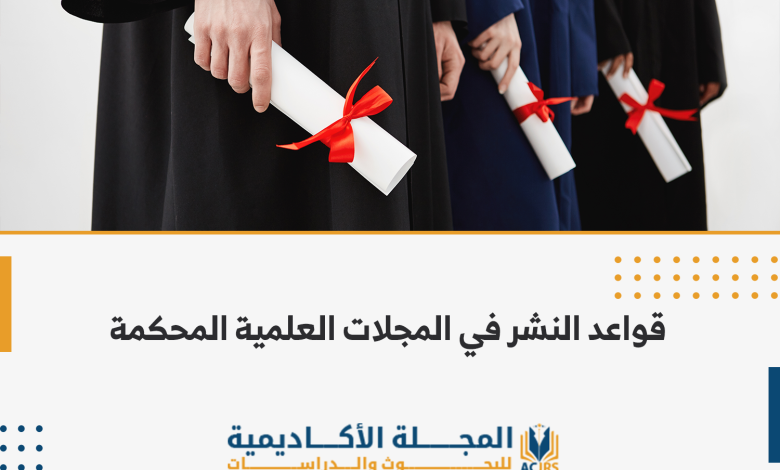Publication Rules in Excellence Scientific Journals

Introduction
As part of supporting and developing scientific research and disseminating knowledge, the Research Excellence Center at El Sheikh Abdallah El-Badri University establishes these rules and conditions to organize the publishing process in its specialized scientific journals:
- Excellence Journal of Medical Sciences
- Journal of Excellence in Engineering Sciences
- Excellence Journal of Humanities and Social Sciences
This document aims to ensure the quality of published research and adherence to research ethics.
Types of publishable materials in excellence scientific journals
To meet the needs of researchers and contribute to enriching scientific knowledge, the Scientific Excellence Journal at El Sheikh Abdallah El-Badri University accepts the following types of materials for publication:
1. Original Research Articles: These include studies that present new and original research findings, with clear objectives, precise scientific methodology, and results supported by reliable data. The research is presented within a range of 5000-8000 words.
2. (Review Articles): The research summarizes and evaluates previously published studies on a specific topic in order to provide a comprehensive overview, provided that it highlights the relationship between the studies and clarifies research gaps. It is preferable to discuss recent trends or provide recommendations for future research. The research is presented within the range of (4000-6000 words), with a preference for covering recent studies (from the last five years) to ensure timeliness.
3. (Short Communications): Scientific publications are designed to present new research results or ideas concisely and quickly. This type of research is used to convey innovative ideas or preliminary results without the need to develop a complete and detailed study. The length of the research should not exceed 1500 to 3000 words.
4. (Case Reports): Detailed reports on individual cases or unique experiences with scientific value should clarify the importance of the case in advancing scientific knowledge or practical practices, while also providing the ethical approvals associated with the case. Reports should preferably be concise and clear, with a length ranging from 1500 to 2500 words.
5. (Opinion or Perspective Articles):
6. (Technical Notes):
7. (Book Reviews):
9.(Educational Articles): Aims to highlight issues of education and learning, focusing on curriculum development, improving teaching practices, or suggesting innovative teaching strategies. These articles seek to provide practical insights that contribute to improving the quality of education and developing its environment, supported by examples and evidence that reinforce the proposed ideas. The suggested length is 3000-5000 words.
10. (Project Reports): The documents highlight completed or ongoing research projects. They include the objectives, methodologies, preliminary or final results, and the significance of the research project to the scientific or applied field. The aim is to provide a comprehensive overview of the project to share knowledge or attract future support. The suggested length is (3000-5000 words).
11. (Letters to the Editor) : These are short comments or notes that interact with the content published in the scientific journal, aimed at providing constructive criticism or clarifications about the targeted article. They should be concise (500-1000 words).
12. (Cultural or Social Case Studies): It focuses on important social or cultural issues in local or international communities. These studies are concerned with understanding the dynamics of human behaviour and cultural interaction in specific contexts, making them an important tool for analysing social and cultural phenomena in depth. They are particularly published in the humanities journal. The study typically ranges from 3000 to 5000 words.
General Publishing Guidelines
- Originality of research
- The research must be new and original and has not been published or submitted for publication elsewhere.
- A signed written statement from all researchers is attached, confirming that the research has not been published or submitted for publication previously.
- Research Ethics
- Adherence to research ethics is required, especially for experiments involving humans or animals.
- Ethical approvals from accredited entities must be attached when necessary.
- scientific affiliation
Research is accepted from both inside and outside the university, provided that it is related to the journal’s fields. The journal encourages collaboration between local and international researchers.
- Language of publication
- The journal accepts research in both Arabic and English, with a commitment to using precise academic language.
- The research written in Arabic must include an abstract in both Arabic and English.
- Research Size
The number of pages of the material submitted for publication should not exceed twenty pages.
- Search format
- The research must be prepared according to the journal’s formatting guidelines (journal template).
- The research is submitted electronically via the journal’s submission system or via the journal’s email in both formats (Word and PDF).
- Abstract
- The abstract should be brief (no more than 200 words).
- The abstract should be written in one paragraph and without numbering.
- Research abstracts written in English do not require translation into Arabic.
- The research written in Arabic must include an abstract in both Arabic and English (the abstract must be written in Arabic first, followed by the English translation. The abstract in English must be identical to the Arabic abstract in terms of meaning and significance).
- The research abstract should cover the following key points:
- Importance of the topic: A brief description of the value of the research and the reasons for choosing it.
- Problem definition: Identifying the problem or research question that the research seeks to address.
- Research methodology: A brief presentation of the methodology used and the methods or tools that were applied.
- Key Findings: Highlighting the most important findings.
- Recommendations: Mention the most important recommendations or practical contributions that the research has produced.
- Importance of the topic: A brief description of the value of the research and the reasons for choosing it.
- The research abstract is formulated in a narrative and concise manner that reflects the essence without the need for detail.
- Keywords related to the research topic are included at the end of the research abstract. The words must be chosen carefully to facilitate the classification of the search in databases.
- Research introduction
- Provides a brief description of the research idea and the general context of the scientific field to which it belongs.
- Explain the reasons for choosing the topic, its objectives, importance, and scientific or practical impact.
- It identifies the added value and contributions that the research makes to the scientific field or society.
- It is preferable to be comprehensive and concise (5-20 lines), avoiding complex terms or length, especially if the introduction is intended for a wide range of people.
- Previous studies
- Selection of recent studies directly related to the research topic.
- Provide a brief analysis of the strengths and weaknesses of each study, identifying gaps or issues that have not been addressed, highlighting the significance of the current research.
- Arrange studies logically (chronologically, thematically, or by methodology).
- Focus on the main points that support the research objectives, while avoiding unnecessary prolongation.
- Commitment to using the approved scientific documentation style (Harvard style).
- Research Methodology
- Determining the justifications for the study and the reasons for interest in the research topic: The methodology begins by clarifying the motives behind choosing the research topic, with a focus on its scientific or practical importance.
- Clarification of the methodology used: specifying the type of methodology used (experimental, descriptive, analytical, comparative, etc.), while clarifying the procedural steps that were followed to achieve the research objectives.
- Detailed tools and resources used: List the devices, tools, software, or samples used in the research, with a clear explanation of the criteria for selecting them to ensure their accuracy and validity.
- Specify where and when the study will be conducted: Specify the location of the study (e.g. laboratory, institution, specific geographic area) and the length of time it took, indicating the circumstances surrounding the study if relevant.
- Explain data collection methods (if applicable): Explain the methods used to collect data (e.g. questionnaires, interviews, field observations).
- Results
- Present the results briefly without going into unnecessary detail, focusing only on the relevant information.
- Linking the results to the research objectives: Explain how each research objective is achieved through the results, and explain the relationship between them.
- Recommendations (Future Work)
- Point out research objectives that have not been achieved or that need further research and development.
- Identify shortcomings or defects discovered during the research, and make suggestions for overcoming them.
- Submit ideas for future research projects that may extend or complement current work.
- Providing practical recommendations that help improve the quality of research or apply it to other fields.
- Recommendations are written briefly and clearly. With emphasis on the future impact of research work in the scientific field.
- Anti-plagiarism
- All research is checked using plagiarism detection software.
- Research papers that exceed the permitted plagiarism rate (20%) will be rejected.
- Arbitration
- The research is checked by the editorial team to ensure that it conforms to the scope of the journal (including format and scientific style). If there are major formatting or grammatical errors, The research is returned to the researcher for modification before sending it for review.
- Expert referees in the scientific field of the research are selected to ensure the accuracy of the evaluation.
Arbitration is usually double-blind review. Where the referee does not know the identity of the researcher,
vice versa. - The referees review the research according to specific criteria including:
- Originality and significance of the research.
- The strength of the methodology used and the accuracy of the results.
- Clarity of writing and organization of research.
- References used and how they relate to the topic.
- Originality and significance of the research.
- The arbitrators shall submit a report which includes:
- Accept the research as it is.
- Accept the research with modifications.
- Research Rejection.
- The arbitrators’ comments are sent to the researcher to make the required amendments.
- In case of major modifications The paper may be returned to the arbitrators for further evaluation.
After the arbitrators approve and modify the research according to their comments,
The editorial team makes the final decision on publication.
- Final procedures for publication
- The final version of the research is reviewed to ensure that it meets all publishing standards.
- Researchers are committed not to send their research to any other party for publication until they receive a response from the journal’s management regarding the eligibility of their research for publication or not.
- Researchers are committed to making the arbitrators’ amendments to their research according to the reports sent to them.
And provide the magazine’s management with the modified version. - The final version is sent to researchers for approval before publication.
- The research will be included in the next issue of the journal and will be announced on the journal’s website.
- Resubmission
- Resubmission of rejected research papers is permitted after making the required modifications.
- The modified search is treated as a new request.
- Intellectual Property Rights
- Once the research is accepted for publication, The magazine retains copyright.
- It is prohibited to republish the research in any form without obtaining written permission from the journal’s management (unless it is in the form of a summary or part of a lecture or thesis).
- Contact and inquiry
All inquiries should be sent to the journal’s dedicated email address (erc@eaeu.edu.s). (https://journals.eaeu.edu.sd) .Or through the website of the Center of Research Excellence


